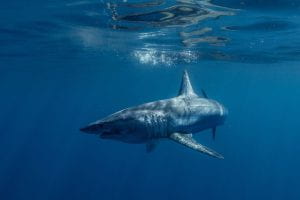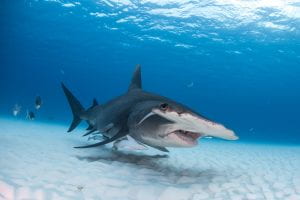Research Raising Red Flags For Great Hammerheads,
Some Hope For Shortfin Makos
FORT LAUDERDALE/DAVIE, Fla. –
Summary: The first-ever chromosome-level genome sequences completed for great hammerhead and shortfin mako sharks have shown that both species have experienced major population declines over a 250,000-year history. Low genetic diversity and signs of inbreeding add a layer of concern to the management of Critically Endangered great hammerhead sharks, whose populations have been in freefall recently due to overfishing for their highly valued fins. In contrast, with a larger effective population size (the ideal breeding population size) in the past and higher genetic diversity, shortfin mako sharks appear equipped to be more resilient to rapid environmental change: that is, if the current fishing pressure on them is substantially reduced.
“With their whole genomes deciphered at high resolution we have a much better window into the evolutionary history of these endangered species,” said Mahmood Shivji, Ph.D., professor at Nova Southeastern University’s (NSU) Halmos College of Arts and Sciences and director of the Save Our Seas Foundation Shark Research Center and NSU’s Guy Harvey Research Institute.
It’s a startling image that describes a milestone in conservation science for sharks. Shivji, Michael Stanhope, Ph.D., from Cornell University’s College of Veterinary Medicine and their collaborators have glanced back in history by sequencing to chromosome level the genomes (entire genetic blueprint) of great hammerhead and shortfin mako sharks. Their DNA timeline shows that their populations have declined substantially over 250,000 years. What the scientists have also found is worrying: great hammerhead sharks have low genetic variation, which makes them less resilient to adapting to our rapidly changing world. The species also shows signs of inbreeding, an issue that can lower the ability of its populations to survive.
The shortfin mako shark, however, showed higher diversity and limited inbreeding, a hopeful glint in the gloomy conservation climate. Understanding change over such a large timescale can put into context the current conservation status of these endangered animals. The results can help direct us towards much more nuanced management strategies for sharks.
The research paper, Genomes of Endangered Great Hammerhead and Shortfin Mako Sharks Reveal Historic Population Declines and High Levels of Inbreeding in Great Hammerhead, has been published in iScience (https://www.sciencedirect.com/science/article/pii/S2589004222020880)
This research was led by Stanhope and Shivji, with collaborators from Cornell University, NSU, Temple University, Governors State University and the San Diego Zoo Wildlife Alliance.
The scientists acquired and assembled entire genome sequences for great hammerhead and shortfin mako sharks and compared their genomes with genome information available for the whale shark, white shark, brownbanded bamboo shark and cloudy catshark. Their methods read like complex puzzle-building by scientific sleuths: successively assembling from tiny fragments of DNA different sequences like a great patchwork tapestry that details the blueprint of life. Reaching chromosome level represents the latest in high-quality whole genome sequence research – and a tricky feat to achieve for species like sharks that have enormous genomes.
They found that great hammerhead sharks have a high probability of inheriting two copies of the same DNA sequence (homozygosity), including various genes, from their parents.
“To understand why this might be undesirable, you can think about it in terms of disease,” said Shivji . “You need two copies of the gene to express certain recessive diseases: one from your mother and one from your father. If you are homozygous for a trait, you have inherited the same gene sequence from both your mother and father, and the trait will be expressed”.
In the case of great hammerhead sharks, showing what the scientists dub “high runs of homozygosity” in their genome means that large sections of their genome were homozygous, increasing the chances of expressing undesirable traits. By contrast, if one inherits two different sequence forms (alleles) of a gene from the mother and the father (i.e., heterozygosity), the effects of the recessive allele can be masked by the dominant allele. If an undesirable trait is recessive in this heterozygous state, it will not be expressed. Shortfin mako sharks had lower runs of homozygosity relative to great hammerheads, a genetic windfall that may stand them in better stead to adapt to change.
The application of advancing techniques comes amidst bleak reports for sharks and rays.
“Technical advances in the study of genomes mean that DNA sequencing approaches are much more powerful and efficient now”, said Stanhope. “We can apply these new technologies to gain insights about the organism, information that we hope can be leveraged to protect sharks and rays”.
While we don’t know exactly the effects of inbreeding in sharks, findings from wolves and cheetahs show that problematic traits can creep in over time. The result is often lowered survival of the species.
The picture for great hammerhead sharks – overfished and traded for their fins – is worrying. But without these critical genetic insights, we would be unable to modify how their vulnerable populations are currently managed.
The researchers are cautious about overstating results.
“Genetics has advanced such that chromosomal level genomes are the expectation for a reference quality genome for species however, conservation research presents its own challenges to achieving this consistently and at the resolution expected in other fields” said Shivji. “Obtaining tissue samples from endangered marine vertebrates is a major hurdle. You can assemble the genome with a single tissue sample from a single shark, but the ideal circumstance would be to sequence genomes from multiple individuals from different parts of their ocean range, an ethically difficult and costly endeavor.”
Indeed, the researchers state this as a limitation of their current study. The ethical limitations to working with endangered species means that conservation geneticists must balance the latest advances with respect for the fragile populations they study. In addition to revealing the genetic diversity and fragile status of two endangered shark species, the researchers hope that their results will provide what they term reference-quality genomes, from which future foundational science can build to improve what we know about sharks. Certainly, as new possibilities arise, our insights into the blueprint of sharks will help strengthen the way we understand these ecologically important species and conserve their vulnerable populations.
Be sure to sign up for NSU’s RSS feed so you don’t miss any of our news releases, guest editorials and other announcements. Please sign up HERE. You can also follow us on Twitter @NSUNews.
###
About Nova Southeastern University (NSU): At NSU, students don’t just get an education, they get the competitive edge they need for real careers, real contributions and real life. A dynamic, private research university, NSU is providing high-quality educational and research programs at the undergraduate, graduate, and professional degree levels. Established in 1964, the university includes 14 colleges, the “theme park” for start-ups, scale-ups , and entrepreneurs, the Alan B. Levan | NSU Broward Center of Innovation, the 215,000-square-foot Center for Collaborative Research, the private PK1-12 grade University School, the world-class NSU Art Museum Fort Lauderdale, and the Alvin Sherman Library, Research and Information Technology Center, one of Florida’s largest public libraries. NSU students learn at our campuses in Fort Lauderdale, Fort Myers, Jacksonville, Miami, Miramar, Orlando, Palm Beach, and Tampa, Florida, as well as San Juan, Puerto Rico, and online globally. With more than 200,000 alumni across the globe, the reach of the NSU community is worldwide. Classified as having “high research activity” by the Carnegie Foundation for the Advancement of Teaching, NSU is one of only 59 universities nationwide to also be awarded Carnegie’s Community Engagement Classification, and is also the largest private institution in the United States that meets the U.S. Department of Education’s criteria as a Hispanic-serving Institution. Please visit www.nova.edu for more information.
About the Save Our Seas Foundation: Founded in Geneva, Switzerland, in 2003, the Save Our Seas Foundation (SOSF) is a philanthropic organization whose ultimate goal is to create a legacy of securing the health and sustainability of our oceans, and the communities that depend on them, for generations to come. Its support for research, conservation and education projects worldwide focuses on Endangered sharks, rays and skates. Three permanent SOSF research and education centers reinforce its actions in Seychelles, South Africa and the USA. Please visit https://saveourseas.com/sosf-shark-research-center for more information.
About Cornell University College of Veterinary Medicine: The College of Veterinary Medicine (CVM) at Cornell University is recognized internationally as a leader in animal medicine, public health, biomedical research, and veterinary medical education. Ranked as one of the top veterinary colleges in the nation by US News & World Report consistently since 2000, the College will continue to excel in providing education through its cutting-edge case-based curriculum and advanced training that prepare veterinarians and scientists to serve society in critical roles in clinical and diagnostic veterinary medicine, public health, scientific inquiry, and public policy. Please visit www.vet.cornell.edu for more information.

